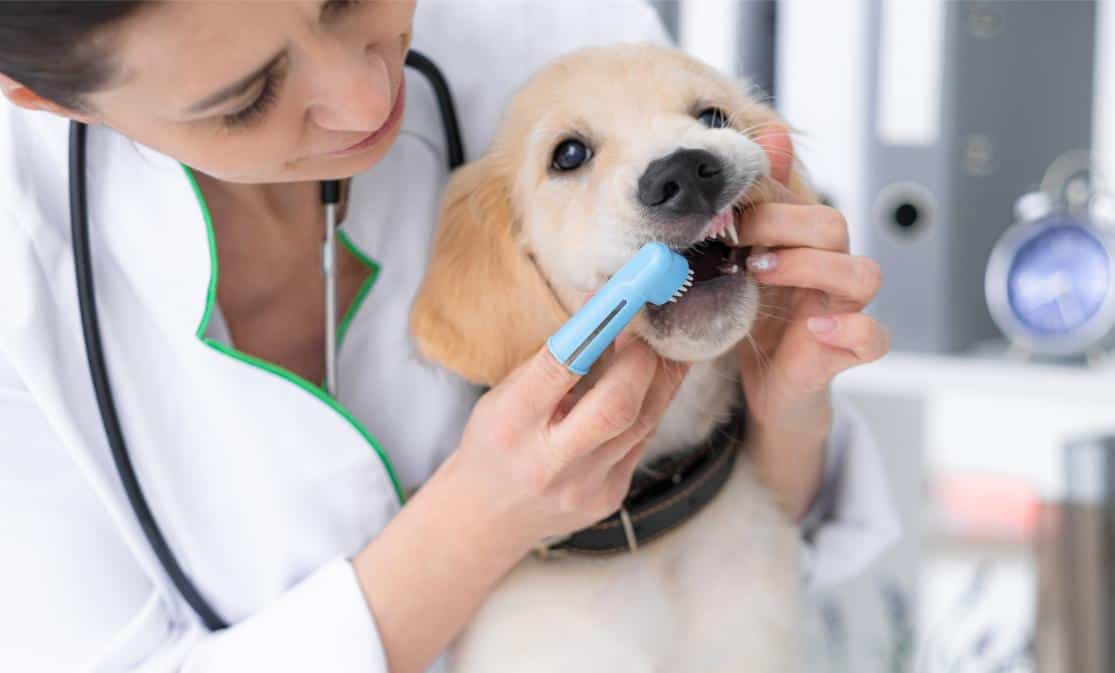How To Brush Your Dog’s Teeth

Bad breath is a common topic among dog owners. Even from an early age, doggie breath can be on the strong side. Without regular intervention, oral bacteria and food particles create a slimy film called plaque, which eventually calcifies into tartar. Without proper treatment, this can lead to periodontal disease, which is progressive and irreversible. Luckily, with routine care, it is 100% preventable.
The Details
Periodontal disease may start with bad breath and red gums, but the last stage of the disease involves pain, broken or cracked teeth, and possible tooth loss. Gum recession, bone loss, and infection can travel through the bloodstream and cause other systemic illness, including liver disease, heart disease, or kidney disease.
More than half of all pets over age three have some form of periodontal disease. While we are here to help treat the problems associated with the gums, there are many things dog owners can do at home to mitigate oral bacteria.
Brushing Your Dog’s Teeth
We understand the confusion that can surround a dog’s oral care routine at home. The more you do it, though, the easier the whole process becomes. After a while, your dog may even enjoy having their teeth brushed! Be sure to do the following:
- Purchase dog toothpaste. Never use toothpaste for humans.
- Keep your dog’s preferred toothbrushes on hand.
- With a little dab of dog toothpaste on your finger, allow them to smell and sniff it. Work up to putting the toothpaste on outer molars. Gentle pressure in a circular motion is the goal, especially on the back teeth.
- At a 45-degree angle, work the toothpaste onto the teeth, paying special attention to the gum line.
- Keep sessions short and rewarding.
Speaking of Treats
We recommend purchasing high-value dental treats that have earned the seal of approval by the Veterinary Oral Health Council. These products can reduce plaque or tartar by 15-20%, and keep teeth healthy and strong. The bonus is that many dental chews also keep dogs entertained and occupied. Just be careful not to leave them alone with dental chews as they could be a choking risk.
The Best of Pet Dental Care
If you ever see any of the following signs, please schedule an appointment with us:
- Yellow or brown discoloration
- Broken, cracked, loose, or missing teeth
- Red or swollen gums
- Foul-smelling breath
- Dropping food, favoring one side of the mouth, abnormal chewing
- Unexplained weight loss
Because the majority of the problems caused by periodontal disease occur beneath the gum line, digital X-rays can reveal the extent of damage to the bone. Conducted under general anesthesia, X-rays, dental exams, and cleanings require diagnostic tests to ensure a pet can safely undergo dental procedures.
What the Future Holds
Depending on what we find during a dental procedure, extractions, medications, and dental sealants may be necessary. We try to save as many teeth as possible, and always have an eye on pain reduction.
Please reach out to us at (540) 832-1751 with any questions about canine dental care. Our team is always happy to help at Crossroads Animal Hospital.
